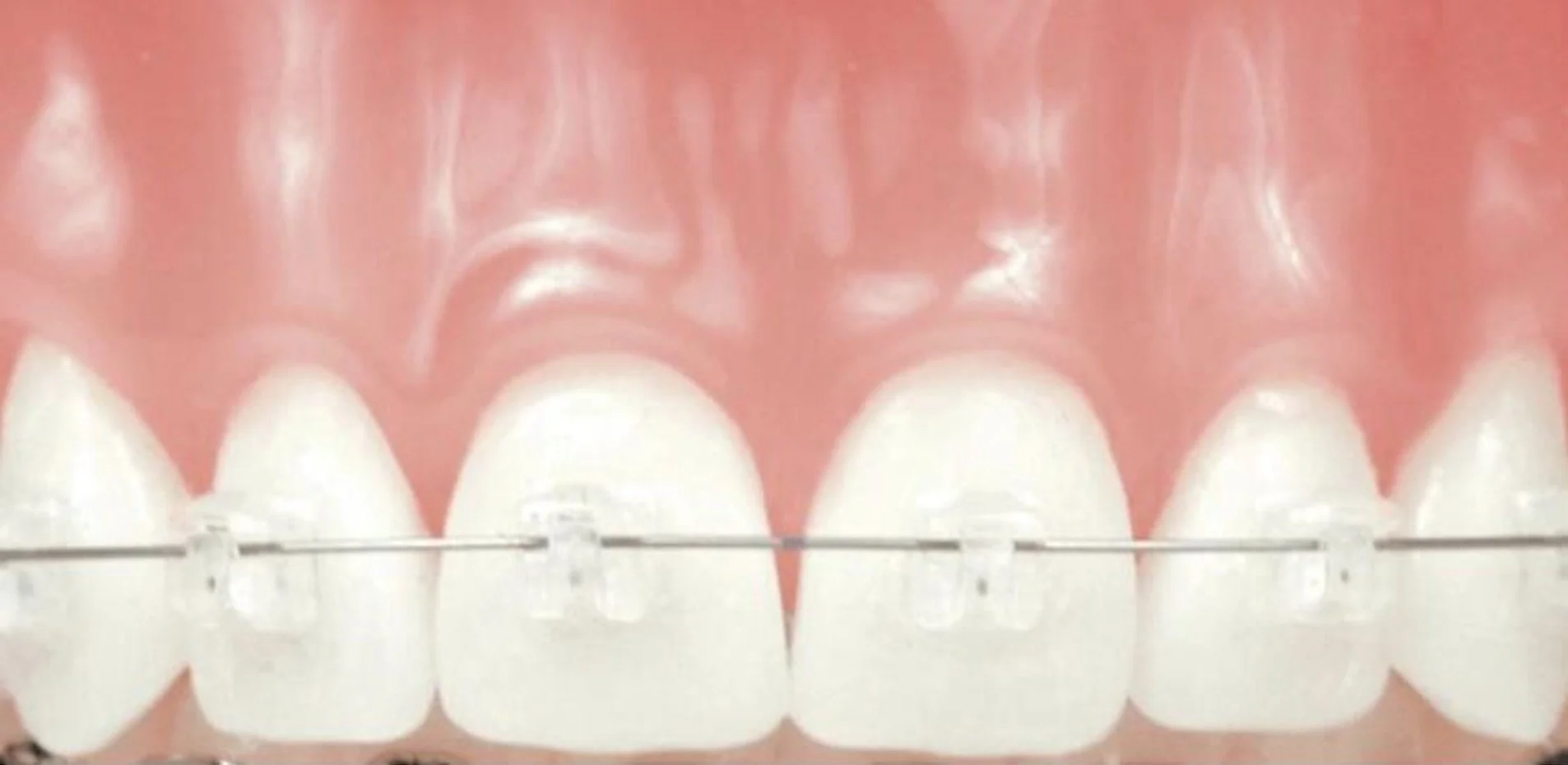fixed Braces for teeth
Explore the benefits of traditional fixed braces for teeth
Traditional Braces
Fixed braces for teeth are the first thing that comes to mind for most people when they think of orthodontic treatment. They are the traditional ‘train track’ look of brackets fitted to the front surface of your teeth and connected with an archwire (and sometimes colourful elastic bands or ties). This system is the tried-and-true method of achieving a straighter smile and, with advancements in technology, fixed braces are more efficient and discreet than ever before!
Clear Braces For Clear Results
At Share a Smile Orthodontics, we use the Damon fixed braces system. The brackets are much smaller than conventional braces, making them more aesthetically pleasing and easier to clean. They also come in metal or clear brackets, the latter becoming almost invisible when paired with a white archwire. Damon teeth braces are a great option for socially conscious teens and working adults who would prefer more discreet braces treatment.
Damon system fixed braces
Traditional fixed braces
Self-Ligating Braces—Faster Treatment, Fewer Practice Visits
Self-Ligating system used to tighten your teeth. This means that the archwire is held in place without elastics or ties. Instead, each bracket has a sliding mechanism that allows the teeth to move freely along the archwire. This means less force is needed to move your teeth to their desired position. Without the friction caused by elastic ties, your teeth can also move into place more quickly despite the gentle nature of the treatment. Because of their self-ligating nature, the braces tighten themselves, reducing the need for in-clinic appointments.
Ready to enjoy the hassle-free, swift treatment that self-ligating braces for teeth provide? Schedule your free consultation today to see if these braces are right for you!
Invisalign Frequently Asked Questions
-
Yes, fixed braces work to quickly and gently realign your teeth.
The amount of pressure applied to the brackets and bands is adjusted over time, meaning that your teeth can move into position in a shorter amount of time than with other orthodontic treatments.
However, the rate at which the braces move your teeth depends on the complexity of your case, so times may vary.
-
When you get fixed braces, you can expect a gradual process of aligning your teeth for the desired result.
It is important to note that fixed braces cannot be removed during your treatment period, so it’s beneficial to take extra care when eating and brushing.
Regular visits with your orthodontist will help ensure that your teeth are being aligned correctly and to check for any potential issues.
With proper care and regular scheduling with your orthodontist, you can expect beautiful straight teeth in no time.
-
With fixed braces, it is recommended to avoid hard, sticky, chewy and sugary foods. This includes things like corn on the cob, apples, popcorn, hard candy, gooey caramel and chewy toffees.
It is also important to brush your teeth thoroughly after each meal or snack to ensure there are no food particles stuck in the brackets and wires.
By avoiding these kinds of food and brushing regularly you can keep your teeth and braces clean and healthy while wearing fixed braces.
-
The duration of treatment with fixed braces will depend on the complexity of the case and your individual circumstances.
Generally, treatment times range from 6-24 months, however in more complex cases, this could take a little longer.
Regular reviews with your orthodontist will help to ensure that you stay on track
-
Depending on the type of teeth braces, both top and bottom teeth can move quickly and evenly.
Generally, depending on your bite and the severity of your misalignment, all teeth can be moved at a similar rate.
With modern treatments such as fixed braces for teeth, you can expect to get results in a shorter amount of time than ever before, with the top and bottom teeth potentially moving at similar rates.
-
The 5 stages of fixed braces are:
(1) Placement, where the orthodontist first attaches the metal or ceramic brackets to your teeth.
(2) Straightening, which is when the thicker wires are adjusted to create gentle pressure and gradually align your teeth.
(3) Tightening, which is when the orthodontist adjusts and tightens the wires every 4-6 weeks.
(4) Removing, which is when the braces are removed after they have done their job.
(5) Retention, which is when you wear either a removable retainer or a fixed retainer to ensure that your teeth stay in their new position.
-
While wearing dental braces, you should still maintain a healthy diet but there is no evidence that they will cause you to lose weight.
However, having straighter teeth may reduce food build-up which can ultimately reduce your risk of cavities and other associated oral health problems.
With regular brush and flossing, you can still enjoy the same foods while protecting your teeth from decay.
-
You’ll need to be careful when eating sticky, hard or crunchy foods while wearing fixed braces. It’s best to avoid eating chewy sweets, hard lollies and popcorn, as these can damage the brackets and wires.
Also avoid crunchy peanut brittle and toffee as well as chewing gum which can also stick to the brackets and pull them off.
-
Every individual experiences pain differently and the amount of pain experienced with fixed braces will depend on how your teeth are moving.
Generally, it is common to experience some discomfort especially after adjustments. Most people describe the pain as similar to having tight rubber bands in the mouth or during orthodontic tightening.
However, your orthodontist can prescribe medications and provide tips which can help reduce any discomfort you may experience.
-
Fixed braces for teeth generally involve three stages.
First, the brackets are attached to each tooth and connected by a wire. Then, thicker wires are placed on the braces and adjusted over time to pressure your teeth and gradually align them further gently.
Finally, the brackets and bands are removed at the end of your treatment when your smile looks straight!
-
Fixed braces are designed to be comfortable and almost unnoticeable. Although your teeth may feel a bit sore when first fitted, after a few days you’ll get used to wearing the brace and won’t even notice it is there.
Our orthodontists can also advise on any foods or activities that should be avoided during treatment so you stay as comfortable as possible.
-
During the first week of wear, it's best to stick to soft or blended foods. Avoid sticky and hard candy, chewy snacks like gum, and crunchy foods like popcorn, apples, and carrots.
You should also avoid acidic beverages and food such as juices or sodas, since these can erode the enamel of your teeth.
Your orthodontist may also provide you with their own list of foods to avoid during the adjustment process.
-
Absolutely! With dental braces, you can enjoy your favourite meals without worrying about your teeth moving around.
Eating with braces is much easier than it used to be, and you can even eat crunchy and sticky foods with ease.
Additionally, the wires in fixed teeth braces help support your jaw structure which makes chewing more comfortable too.
-
The first week of braces can be challenging for many who are not used to having them, however it is important that you take care when eating.
You should stick to softer foods that don’t require a lot of chewing and avoid hard or sticky food such as crunchy nuts or chewy candies.
Additionally, make sure to drink plenty of water with meals as this will help keep your mouth hydrated and reduce discomfort.
-
Braces are typically tightened every 6 to 8 weeks, depending on your individual treatment plan.
This process is called an adjustment, and it is how the orthodontist can make sure that your teeth are gradually moving into the desired position.
During this time, new wires are placed and adjusted to create gentle pressure which gradually aligns your teeth.
-
Yes, fixed braces for teeth can change your jawline. By straightening your teeth and aligning your bite, the shape of your jawline and facial profile can be enhanced.
With careful planning and a well-executed treatment plan, braces can even correct asymmetry in some cases.
Dental braces are an effective way to make subtle changes in the appearance of your face, giving you a more confident smile in the long run.
-
Getting the braces fitted can be a bit uncomfortable, but the most painful part of the process is likely to be when you get your braces tightened.
During this process, tension is applied to the braces wire which gradually moves your teeth into their new positions.
This can cause some discomfort and soreness in your mouth, but it should only last for a few days.
-
The teeth that are hardest to move with braces are the wisdom teeth, molars, and premolars. These teeth tend to be deeper and have more roots which make them harder for the brace to move.
However, with regular visits to your orthodontist and a good orthodontic plan, these teeth can still be moved into proper alignment.
-
Fixed braces may feel tight and uncomfortable at first, but these feelings should subside after a few days.
You may also experience some tenderness on your gums and teeth, but this should go away as you get used to wearing the braces.
With regular adjustments, your teeth will gradually become aligned, giving you the straight smile you have always wanted.
-
Yes, braces can fix bad teeth. Braces can help to straighten your teeth, close gaps and improve your overall oral health and appearance.
Fixed braces are a popular choice as they ensure that your teeth stay properly aligned throughout the treatment period.
Your dentist will be able to advise if fixed braces are suitable for you and can provide more information about what to expect during the process.




